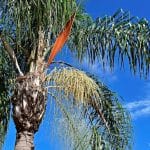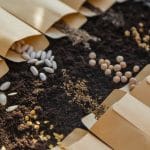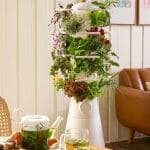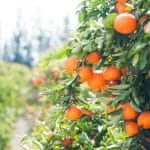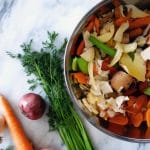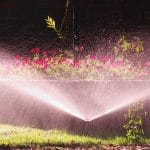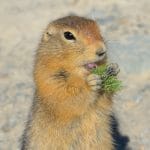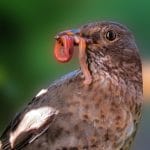Gardening Glossary: Terms & Definitions
Guides

Your Guide to Common Gardening Terms
Use this glossary like a shed-side cheat sheet.
A — Acidic Soil, Aeration, Annuals
Acidic Soil (low pH soil)
Soil with pH < 7. Blueberries, azaleas, and rhododendrons thrive; many veggies prefer closer to neutral. #acidic-soil
Aeration (improving soil airflow)
Loosening compacted soil so roots get air and water moves freely. Worms, broadforks, and core aerators help. #aeration
Alkaline Soil (high pH soil)
Soil with pH > 7. Common in arid regions. Mediterranean herbs like lavender do well. #alkaline-soil
Amendment (soil improvement materials)
Anything mixed into soil to improve structure or nutrition—compost, manure, lime, gypsum, sand. #amendment
Annual Plants (one-season growers)
Sprout, flower, set seed, and die within a single growing season (zinnias, lettuce). #annual-plants
Auxins (plant growth hormones)
Hormones that drive root formation and stem elongation; used in rooting powders for cuttings. #auxins
B — Bare Root, Biennial, Bolting
Bare-Root Plants (dormant, soil-free)
Trees, berries, and roses sold dormant with no potting mix—plant early spring while still dormant. #bare-root
Biennial Plants (two-year life cycle)
Leafy growth year one; flowers and seeds year two (carrots, parsley, foxglove). #biennial-plants
Biological Control (beneficial insects)
Using predators and parasites—like lady beetles or nematodes—to reduce pests. #biological-control
Bolting (premature flowering)
Greens send up a flower stalk from heat or stress; leaves turn bitter. #bolting
Broadcast Seeding (scatter planting)
Spreading seed across the surface for meadows, cover crops, or microgreens. #broadcast-seeding
Budwood (grafting buds)
Dormant buds used for budding fruit trees and roses onto rootstock. #budwood
C — Compost, Companion Planting, Cold Frames
Chitting Potatoes (pre-sprouting)
Starting eyes indoors for a head start in cool climates. #chitting
Chlorosis (yellowing leaves)
Loss of green color, often from iron deficiency or poor drainage; check pH and watering. #chlorosis
Cold Frame (season extender)
Low box with clear lid that traps heat; transition space for hardening off seedlings. #cold-frame
Companion Planting (mutual benefits)
Pairing plants that support each other—basil with tomatoes, corn with beans. #companion-planting
Compost (decomposed organic matter)
Kitchen scraps and yard waste turned into soil food; improves structure and moisture retention. #compost
Cover Crops (green manure)
Clover, rye, vetch grown to feed soil, suppress weeds, and prevent erosion. #cover-crops
Crop Rotation (moving plant families)
Changing bed locations each year to reduce disease and pest buildup. #crop-rotation
D — Deadheading, Drip Irrigation, Drainage
Deadheading (remove spent blooms)
Snip faded flowers to push more blooming and tidy plants. #deadheading
Deciduous Plants (leaf drop in winter)
Trees and shrubs that shed leaves seasonally (maples, apples). #deciduous-plants
Direct Sowing (seed in place)
Planting seeds straight into the bed rather than starting indoors. #direct-sowing
Division (split perennials)
Cutting clumps (daylilies, hostas) into sections to rejuvenate and multiply. #division
Drainage (water movement in soil)
How quickly water passes through; poor drainage suffocates roots. #drainage
Drip Irrigation (slow, targeted watering)
Delivers water to the root zone, reducing waste and foliar disease. #drip-irrigation
E — Espalier, Evergreens, Evapotranspiration
Espalier (train flat against support)
Shaping fruit trees along wires or walls to save space and boost sun exposure. #espalier
Evergreen Plants (year-round foliage)
Plants that keep leaves through winter (boxwood, rosemary). #evergreen-plants
Evapotranspiration (water loss)
Combined evaporation and plant transpiration; informs smart watering schedules. #evapotranspiration
F — Fertilizer, Frost Dates, Foliar Feeding
Fertilizer (plant nutrients)
Organic or synthetic inputs supplying N-P-K and micronutrients. #fertilizer
Foliar Feeding (leaf feeding)
Applying diluted nutrients to leaves for quick uptake; best in cool hours. #foliar-feeding
Frost Dates (last/first frost)
Average spring/fall frost timing used to plan planting and protection. #frost-dates
Fungus Gnat (indoor pest)
Tiny flies in potting mix; allow drying between waterings and use sticky traps. #fungus-gnat
G — Germination, Grafting, Green Manure
Germination (seed sprouting)
Seed wakes and sends out root and shoot under the right moisture/temperature. #germination
Grafting (join plants)
Attaching a scion to rootstock to combine strengths; common in fruit trees. #grafting
Green Manure (tilled-in cover crop)
Cover crops incorporated to boost organic matter and nutrients. #green-manure
Greywater (reused household water)
Lightly used water (sinks, showers) diverted to irrigate ornamentals where legal. #greywater
H — Hardening Off, Hardiness Zones, Heirlooms
Hardening Off (outdoor acclimation)
Gradually exposing seedlings to sun and wind before planting out. #hardening-off
Hardiness Zones (USDA plant zones)
Guides winter survival by lowest average temperatures for your region. #hardiness-zones
Heirloom Seeds (open-pollinated)
Older varieties grown for flavor and diversity; seeds come true each year. #heirloom-seeds
Humus (stable organic matter)
Fully decomposed material that improves structure, moisture, and nutrient holding. #humus
I — IPM, Intercropping, Indeterminate Tomatoes
Indeterminate Tomatoes (vining types)
Continue to grow and fruit until frost; need staking or trellising. #indeterminate-tomatoes
Integrated Pest Management (IPM)
Observe first, prevent next, intervene last—with the least-toxic method that works. #ipm
Intercropping (mixing crops)
Growing complementary species together for space use and pest confusion. #intercropping
Irrigation Zones (watering groups)
Grouping plants with similar water needs to avoid over- or under-watering. #irrigation-zones
J — J-Rooting, Japanese Beetles
J-Rooting (misplaced roots)
Roots bent upward in planting hole—common with seedlings planted too shallow or cramped. #j-rooting
Japanese Beetle (leaf skeletonizer)
Metallic green beetle that chews foliage; hand-pick in the cool morning. #japanese-beetle
K — Kelvin, Keyhole Beds, Knock Out Roses
Kelvin (grow light color temperature)
Measures light color; 5000–6500K is common for seed starting. #kelvin
Keyhole Bed (access-friendly bed)
Round raised bed with a notch for easy reach and compost basket in the center. #keyhole-bed
Knock Out Roses (low-maintenance rose)
Popular landscape roses known for disease resistance and repeat bloom. #knockout-roses
L — Loam, Lime, Leggy Seedlings
Leggy Seedlings (stretched plants)
Tall, weak stems from low light; lower light distance or add supplemental light. #leggy-seedlings
Loam Soil (balanced texture)
Ideal blend of sand, silt, and clay—drains well yet holds moisture. #loam-soil
Leaf Mold (composted leaves)
Slow-rotted leaves that boost water-holding and soil life. #leaf-mold
Lime (raise soil pH)
Calcium carbonate or dolomitic lime used to reduce acidity; apply per soil test. #lime
M — Mulch, Mycorrhizae, Micronutrients
Micronutrients (trace elements)
Boron, iron, manganese, zinc, etc.—small amounts, big roles in plant health. #micronutrients
Mulch (soil cover)
Straw, leaves, wood chips, or compost to conserve moisture and suppress weeds. #mulch
Mycorrhizae (beneficial fungi)
Fungi that partner with roots, improving nutrient and water uptake. #mycorrhizae
Moisture Meter (soil water tool)
Probe that estimates soil moisture at root depth to prevent overwatering. #moisture-meter
N — Nitrogen, No-Dig, Nematodes
Nitrogen (N in N-P-K)
Primary nutrient for leafy growth; excess can reduce fruiting. #nitrogen
No-Dig Gardening (minimal till)
Building soil by layering organic matter on top rather than tilling. #no-dig
Nematodes (good & bad worms)
Microscopic roundworms; some damage roots, others control pests. #nematodes
O — Organic Matter, Open-Pollinated, Overwintering
Open-Pollinated Seeds (stable genetics)
Pollinated naturally; saved seed grows true to type. #open-pollinated
Organic Matter (decomposed life)
Compost, manures, leaf mold—feeds soil microbes and improves structure. #organic-matter
Overseeding (thicken coverage)
Adding seed to existing stands to fill gaps—lawns, cover crops, wildflower meadows. #overseeding
Overwintering (winter survival)
Helping plants make it through cold using mulch, covers, or indoor shelter. #overwintering
P — pH, Perennials, Pruning
pH (soil acidity/alkalinity)
0–14 scale; most vegetables prefer 6.0–7.0 for nutrient availability. #ph
Perennial Plants (return each year)
Live multiple seasons (asparagus, lavender, peonies). #perennial-plants
Phosphorus (P in N-P-K)
Supports roots, flowers, and fruit set; too much can lock out micronutrients. #phosphorus
Pinching (promote branching)
Removing a growing tip to encourage bushier plants (basil, mums). #pinching
Pollination (pollen transfer)
Bees, wind, or hand pollination move pollen so fruits and seeds form. #pollination
Potash (potassium source)
Supplies K for vigor, disease tolerance, and fruit quality. #potash
Potting Mix (soilless medium)
Peat/coir, perlite, bark, compost—designed for containers and drainage. #potting-mix
Pricking Out (up-pot seedlings)
Moving tiny seedlings to roomier cells or pots to grow on. #pricking-out
Pruning (selective cutting)
Removing stems or branches to shape plants, improve light, and increase fruiting. #pruning
Q — Quiescence, Quicklime vs Garden Lime
Quiescence (temporary rest)
A pause in growth due to environmental conditions; resumes when conditions improve. #quiescence
Quicklime vs. Garden Lime (pH products)
Quicklime is caustic and not for gardens; use agricultural (garden) lime to raise pH safely. #quicklime-vs-garden-lime
R — Raised Beds, Rhizomes, Row Cover
Raised Beds (elevated gardens)
Framed soil above grade for better drainage, access, and soil control. #raised-beds
Rhizomes (underground stems)
Horizontal stems that send up shoots and roots (ginger, iris). #rhizomes
Root Bound (circling roots)
Pot-tight roots that need teasing apart and a bigger container. #root-bound
Rootstock (grafting base)
The rooted part that provides vigor/disease resistance to the grafted scion. #rootstock
Row Cover (frost & pest fabric)
Light fabric that protects from cold and insects while letting in light and water. #row-cover
S — Soil Test, Scarification, Succession Planting
Scarification (nick tough seeds)
Scratching/soaking to help hard seeds absorb water and sprout. #scarification
Seed Stratification (chilling seeds)
Cold treatment that breaks dormancy for species like milkweed and many trees. #seed-stratification
Self-Seeding (natural reseeding)
Plants that drop seed and return on their own (cilantro, calendula). #self-seeding
Side-Dressing (midseason feeding)
Applying fertilizer or compost around growing plants. #side-dressing
Silage Tarp (bed prep tarp)
Black tarp used to smother weeds and pre-sprout weed seeds before planting. #silage-tarp
Soil Test (nutrients & pH)
Lab or kit analysis guiding lime and fertilizer needs. #soil-test
Succession Planting (staggered sowing)
Planting in waves for continuous harvests rather than one big flush. #succession-planting
T — Taproot, Tilth, Trellis
Taproot (primary root)
Strong central root (carrot, dandelion) that dives deep for moisture. #taproot
Tilth (workable soil condition)
Crumbly, well-structured soil that’s easy to plant and promotes root growth. #tilth
Top-Dressing (surface composting)
Spreading compost or amendments on top without digging them in. #top-dressing
Transplanting (move and set)
Relocating seedlings or plants to their final position with minimal root shock. #transplanting
Trellis (vertical support)
Frames or netting for climbers like peas, beans, and cucumbers. #trellis
U — Understory, Urea, Urban Gardening
Understory (lower canopy layer)
Shade-tolerant plants growing beneath taller trees and shrubs. #understory
Urea (nitrogen source)
High-N fertilizer; use carefully to avoid leaf burn and runoff. #urea
Urban Gardening (small-space growing)
Containers, vertical systems, and micro-beds for patios, balconies, and rooftops. #urban-gardening
V — Variegation, Vermicomposting, Volunteers
Variegation (multi-colored leaves)
Leaves with white, yellow, or pink patterns; can be sun-sensitive. #variegation
Vermicomposting (worm composting)
Red wigglers convert scraps into rich castings—great for seedlings. #vermicomposting
Volunteer Plants (self-started)
Unplanned seedlings from last year’s drops; thin or transplant as needed. #volunteer-plants
W — Watering Deep, Weed, Wilt
Watering Deep (root-zone soaking)
Fewer, deeper sessions train roots down and increase drought resilience. #watering-deep
Weather Shielding (frost & heat protection)
Use row covers, shade cloth, and windbreaks to protect tender crops. #weather-shielding
Weed (unwanted plant)
Any plant where you don’t want it; mulch and sharp tools are your friends. #weed
Wilt (loss of turgor)
Drooping from heat, drought, root damage, or disease; diagnose before watering more. #wilt
X — Xeriscaping, Xylem
Xeriscaping (low-water landscaping)
Designing with drought-tolerant plants and mulch to cut irrigation needs. #xeriscaping
Xylem (water-transport tissue)
Plant tissue that moves water and minerals from roots upward. #xylem
Y — Yardening, Yellow Sticky Traps
Yardening (home garden care)
Everyday landscape tasks—mowing, mulching, pruning, planting. #yardening
Yellow Sticky Traps (pest monitoring)
Cards that attract and catch flying pests like whiteflies and fungus gnats. #yellow-sticky-traps
Z — Zen Garden, Zinc Deficiency
Zen Garden (minimalist landscape)
Raked gravel, stones, and carefully placed plants to create calm and focus. #zen-garden
Zinc Deficiency (micronutrient issue)
Stunted growth and small leaves; verify with a soil test before amending. #zinc-deficiency
Gardening Terms FAQ
What is loam in gardening?
Loam is a balanced soil of sand, silt, and clay that drains well and holds moisture—ideal for most plants.
What does N-P-K mean on fertilizer?
N stands for nitrogen (leaf growth), P for phosphorus (roots/flowers), and K for potassium (overall vigor).
How do I find my planting zone?
Use the USDA Hardiness Zone map to see which plants survive your winter temperatures.
Share this post
Table of Contents
- Your Guide to Common Gardening Terms
- A — Acidic Soil, Aeration, Annuals
- Acidic Soil (low pH soil)
- Aeration (improving soil airflow)
- Alkaline Soil (high pH soil)
- Amendment (soil improvement materials)
- Annual Plants (one-season growers)
- Auxins (plant growth hormones)
- B — Bare Root, Biennial, Bolting
- Bare-Root Plants (dormant, soil-free)
- Biennial Plants (two-year life cycle)
- Biological Control (beneficial insects)
- Bolting (premature flowering)
- Broadcast Seeding (scatter planting)
- Budwood (grafting buds)
- C — Compost, Companion Planting, Cold Frames
- Chitting Potatoes (pre-sprouting)
- Chlorosis (yellowing leaves)
- Cold Frame (season extender)
- Companion Planting (mutual benefits)
- Compost (decomposed organic matter)
- Cover Crops (green manure)
- Crop Rotation (moving plant families)
- D — Deadheading, Drip Irrigation, Drainage
- Deadheading (remove spent blooms)
- Deciduous Plants (leaf drop in winter)
- Direct Sowing (seed in place)
- Division (split perennials)
- Drainage (water movement in soil)
- Drip Irrigation (slow, targeted watering)
- E — Espalier, Evergreens, Evapotranspiration
- Espalier (train flat against support)
- Evergreen Plants (year-round foliage)
- Evapotranspiration (water loss)
- F — Fertilizer, Frost Dates, Foliar Feeding
- Fertilizer (plant nutrients)
- Foliar Feeding (leaf feeding)
- Frost Dates (last/first frost)
- Fungus Gnat (indoor pest)
- G — Germination, Grafting, Green Manure
- Germination (seed sprouting)
- Grafting (join plants)
- Green Manure (tilled-in cover crop)
- Greywater (reused household water)
- H — Hardening Off, Hardiness Zones, Heirlooms
- Hardening Off (outdoor acclimation)
- Hardiness Zones (USDA plant zones)
- Heirloom Seeds (open-pollinated)
- Humus (stable organic matter)
- I — IPM, Intercropping, Indeterminate Tomatoes
- Indeterminate Tomatoes (vining types)
- Integrated Pest Management (IPM)
- Intercropping (mixing crops)
- Irrigation Zones (watering groups)
- J — J-Rooting, Japanese Beetles
- J-Rooting (misplaced roots)
- Japanese Beetle (leaf skeletonizer)
- K — Kelvin, Keyhole Beds, Knock Out Roses
- Kelvin (grow light color temperature)
- Keyhole Bed (access-friendly bed)
- Knock Out Roses (low-maintenance rose)
- L — Loam, Lime, Leggy Seedlings
- Leggy Seedlings (stretched plants)
- Loam Soil (balanced texture)
- Leaf Mold (composted leaves)
- Lime (raise soil pH)
- M — Mulch, Mycorrhizae, Micronutrients
- Micronutrients (trace elements)
- Mulch (soil cover)
- Mycorrhizae (beneficial fungi)
- Moisture Meter (soil water tool)
- N — Nitrogen, No-Dig, Nematodes
- Nitrogen (N in N-P-K)
- No-Dig Gardening (minimal till)
- Nematodes (good & bad worms)
- O — Organic Matter, Open-Pollinated, Overwintering
- Open-Pollinated Seeds (stable genetics)
- Organic Matter (decomposed life)
- Overseeding (thicken coverage)
- Overwintering (winter survival)
- P — pH, Perennials, Pruning
- pH (soil acidity/alkalinity)
- Perennial Plants (return each year)
- Phosphorus (P in N-P-K)
- Pinching (promote branching)
- Pollination (pollen transfer)
- Potash (potassium source)
- Potting Mix (soilless medium)
- Pricking Out (up-pot seedlings)
- Pruning (selective cutting)
- Q — Quiescence, Quicklime vs Garden Lime
- Quiescence (temporary rest)
- Quicklime vs. Garden Lime (pH products)
- R — Raised Beds, Rhizomes, Row Cover
- Raised Beds (elevated gardens)
- Rhizomes (underground stems)
- Root Bound (circling roots)
- Rootstock (grafting base)
- Row Cover (frost & pest fabric)
- S — Soil Test, Scarification, Succession Planting
- Scarification (nick tough seeds)
- Seed Stratification (chilling seeds)
- Self-Seeding (natural reseeding)
- Side-Dressing (midseason feeding)
- Silage Tarp (bed prep tarp)
- Soil Test (nutrients & pH)
- Succession Planting (staggered sowing)
- T — Taproot, Tilth, Trellis
- Taproot (primary root)
- Tilth (workable soil condition)
- Top-Dressing (surface composting)
- Transplanting (move and set)
- Trellis (vertical support)
- U — Understory, Urea, Urban Gardening
- Understory (lower canopy layer)
- Urea (nitrogen source)
- Urban Gardening (small-space growing)
- V — Variegation, Vermicomposting, Volunteers
- Variegation (multi-colored leaves)
- Vermicomposting (worm composting)
- Volunteer Plants (self-started)
- W — Watering Deep, Weed, Wilt
- Watering Deep (root-zone soaking)
- Weather Shielding (frost & heat protection)
- Weed (unwanted plant)
- Wilt (loss of turgor)
- X — Xeriscaping, Xylem
- Xeriscaping (low-water landscaping)
- Xylem (water-transport tissue)
- Y — Yardening, Yellow Sticky Traps
- Yardening (home garden care)
- Yellow Sticky Traps (pest monitoring)
- Z — Zen Garden, Zinc Deficiency
- Zen Garden (minimalist landscape)
- Zinc Deficiency (micronutrient issue)
- Gardening Terms FAQ
- What is loam in gardening?
- What does N-P-K mean on fertilizer?
- How do I find my planting zone?
All categories
More From The Garden
Disclosure: This post may contain affiliate links. That means if you click and buy, The Bright Garden may earn a small commission, at no extra cost to you. We only recommend products we’ve vetted and believe will benefit our readers.

